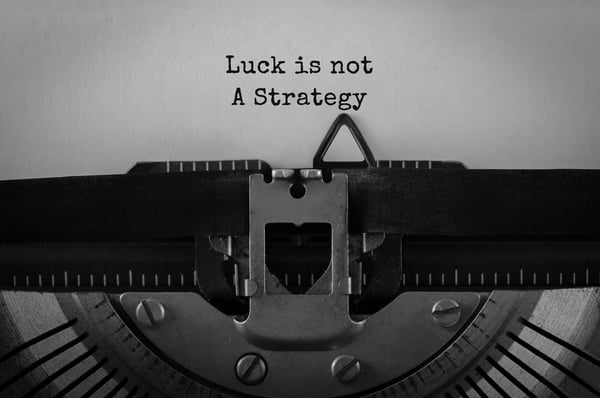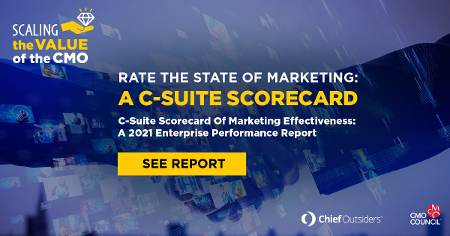CEO Blog - Advice for CEOs on growth and scaling
Your Strategic Marketing Plan: Five Gotchas to Avoid

Written by: Paul Sparrow, Area Managing Partner & CMO, and Don Lee, Partner & CEO, both of Chief Outsiders
The city of Las Vegas is an interesting study in best intentions -- resplendent with people hoping that the flip of a card or the roll of the dice will produce luck-driven riches. About 150 percent of the time, our protagonists leave with empty pockets and dashed hopes.
If luck is so evasive in Sin City, what makes anyone think it’s the foundation for any serious effort? Unfortunately, we see it all the time – a well-meaning entrepreneur or CEO employing instinct and a mega-watt smile, hoping to achieve Bezos-like success.
We need look no further than the great business prophet, Peter Drucker, who once said: “Luck never built a business. Prosperity and growth come only to the business that systematically finds and exploits its potential.”
So, for those CEOs scratching your heads about why your business isn’t growing as fast as you’d like, perhaps it’s time to set aside high-stakes gambling and apply some science – in particular, marketing science – to your growth aspirations.
A good strategic marketing plan is a foundation upon which you can build success – a tool that will educate prospects, attract customers, and retain buyers for the long term. But, like any disciplined approach, it requires some rethinking of the conventions standing in your way.
At Chief Outsiders we spend our time crisscrossing the country, meeting with CEOs who are looking for ways to jump-start their growth engine. In our experiences, there are five common obstacles to growth that recur time and again. Here are our observations:
- Sales vs. Marketing: In the small and mid-size space, we often see businesses where marketing is the slave of sales, and that's not exactly the functional focus you want. Marketing today is a true leader of your go-to-market plan – charged with bending the minds of consumers toward your products and services.
This is when the big “M” of marketing – the strategic side – is best actualized, creating a cohesive glue that bonds sales and marketing together. Especially in the digital age, marketing has a much larger sphere across the buyers’ journey – responsible for so much of the front-end influence that sales needs to carry prospects through the evaluation and purchasing step.
This alliance looms large today – so mighty that it requires the contextual insights of the great philosopher, Sun Tzu, who said that tactics without strategy are the path to defeat. We would add that strategy, without tactics, is kind of like the slow boat to China – so the proper plan requires a strategic roadmap supported by tactical execution in order to achieve success. And not the other way around. Simply throwing a handful of tactics against the wall to see which ones stick will likely cost a lot of money and could even cause your gambling career to literally crap out. - Random Acts of Marketing: We see many businesses engage in random acts of marketing – the “pin the tail on the donkey” approach to awareness – and it simply doesn’t move the needle, in a world where every marketing dollar is under scrutiny. There’s an old saying among CEOs – “I'm spending lots of money on marketing, and half of its working -- I just don't know which half” – that likely was coined by a leader who was wasting money on said randomness.
At Chief Outsiders, we have a method of eliminating the scattershot called the “Growth Gears” – a three-stage process focused on gathering Insights and creating Strategy BEFORE committing to Execution. These are three relatively simple gears, that work in linear order. In so doing, you eliminate things like gut feel and instinct, and apply real analysis and findings, to your go-to-market plan. - Running vs. Growing Your Business: It can be problematic when the CEO doesn’t just sail the ship, but also insists on being the head cook and bottle washer. We often encounter companies that want to cross the chasm into the next stage of growth, but the CEO hasn’t loosened the grip enough to foster the creation of a good strategic growth plan.
When it comes to a renewed focus on growth, you, Mr. CEO, need to simply drive. As the head of the company, you have to not only own the growth planning process, but know when and how to delegate responsibility to others in your leadership team. - The Changing Buyers’ Journey: It is said that about 70 percent of the buying journey has been completed by the time a prospect rings your (proverbial) doorbell. Buyers are looking at your website, they're looking at other sites to validate your offering, and they’re Googling competitors, before contacting a single salesperson. And that’s only true if they actually speak with your sales department – nearly half of millennials say they don’t want ANY human interaction.
This changed journey means companies must spruce up their digital brand and invest in some new thinking – for example, maybe a chatbot that serves as a digital ambassador for your company. And by all means, invest in analytics, so you can evaluate the effectiveness of your digital channel. - CEOs Who Are Reactionary in their Growth Plan: A lack of focus and organization can be a growth-killer. We call it the shiny object effect – an unproven or wayward idea that sucks up resources like a sponge. Once you develop your market-driven growth plan, stick to it with all you’ve got.
A good marketing plan is like the playbook of a football team -- everybody's got their role, everybody has their different positions within the company and everyone is aligned behind the strategy. Toss out the playbook, and you’ll likely go 0-16 on the season.
You know, the great theologian, Mike Tyson, once said -- and this is very true: “Everyone has a plan until they get punched in the mouth.” In our world, a good strategic plan actually is built around the likelihood of receiving a punch or two – so you have a plan to avoid getting socked in the kisser, as well as one for how to react after you get slugged.
Can one of us help train you to become a marketing prize fighter? We’d love to have an exploratory conversation. Please reach out.
Authors
Paul Sparrow, Area Managing Partner & CMO, Chief Outsiders
https://www.chiefoutsiders.com/profile/paul-sparrow
psparrow@chiefoutsiders.com
Don Lee, Partner & CMO, Chief Outsiders
https://www.chiefoutsiders.com/profile/don-lee
dlee@chiefoutsiders.com
Topics: Marketing Strategy, Fractional CMO
Mon, Jun 28, 2021Featured Chief Outsider
/CMO-Paul-Sparrow.jpg?width=200&height=200&name=CMO-Paul-Sparrow.jpg)
Paul Sparrow
Related Articles

- Press Releases
- Careers
- Case Studies
- Marketing Consultant Company
- Marketing Strategy Consultants
- Marketing Plan Consultants
- B2B Marketing Consultants
- Virtual CMO
- Marketing Consultant Outsourcing
- Fractional CMO
- What is a Fractional CMO
- Healthcare Marketing Consultant
- Marketing Consultant Houston TX Texas
- Marketing Consultant Texas TX
- Marketing Consultant Bay Area
- CEO Blog
- Ebooks Plus
- Executive Marketing Consultants
- Product Marketing Consultants
- B2C Marketing Consultants
- Virtual Marketing Consultants
- Senior Marketing Consultants
- Temporary CMO
- Hire a CMO
- Fractional CMO Salary
- Fractional CMO Responsibilities
- Marketing Consultant Austin TX Texas
- Marketing Consultant Dallas TX Texas
- Marketing Consultant San Antonio
- Helping Private Equity
- Private Equity Blog
- Leadership Team
- Privacy Policy
- Business Marketing Consultants
- Strategic Marketing Consultants
- Marketing Technology Consultants
- Sales and Marketing Consultants
- CMO Job Description
- CMO Salary
- Fractional CMO Agency
- Fractional CMO Services
- CPG Marketing Consultant
- Marketing Consultant San Diego
- Partners
Houston, TX 77056
© 2023 Chief Outsiders


